No 47 - 2024
Acute and Chronic Hepatitis B and C, 2023
Acute and Chronic Hepatitis B and C, 2023
Hepatitis B
For a detailed epidemiological review, refer to the annual report on acute and chronic hepatitis B 2023.
Acute Hepatitis B
The Department of Infectious Disease Epidemiology and Prevention received nine notifications of individuals with acute hepatitis B in 2023. By comparison, ten cases were reported in 2022. The majority of acute cases contracted the disease in Denmark, with sexual transmission being the most common mode of infection. Overall, there has been no change in the annual number of acute hepatitis B cases over the past ten years. The median age of acute cases in 2023 was 42 years (range: 20–72 years).
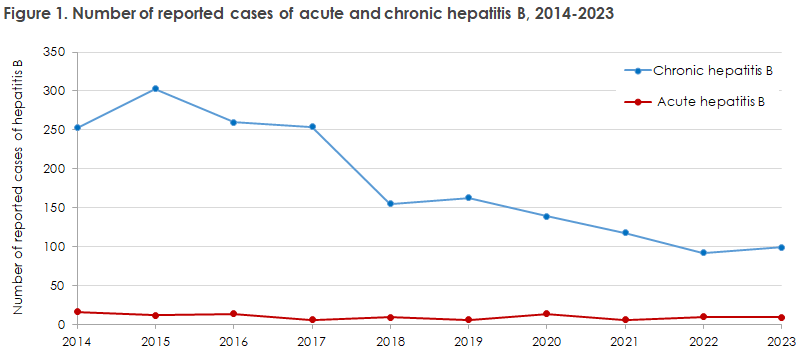
Chronic Hepatitis B
In 2023, 99 cases of chronic hepatitis B were reported. A slight increase in cases was observed from 2022 to 2023, but the overall trend is declining (Figure 2).
The vast majority of chronic hepatitis B cases in 2023 were among individuals of non-Danish origin, presumed to have been infected before arriving in Denmark, most likely at birth. A few cases of nosocomial (hospital-acquired) infection were reported from abroad, but none in Denmark.
In 2023, 57% of chronic hepatitis B cases were women. The median age was 34 years for women (range: 19–63 years) and 42 years for men (range: 23–78 years). The predominance of women is influenced by the systematic screening of pregnant women.
Slightly over half of the women diagnosed with chronic hepatitis B were identified through general prenatal screening. No children were reported as infected at birth in Denmark in 2023.
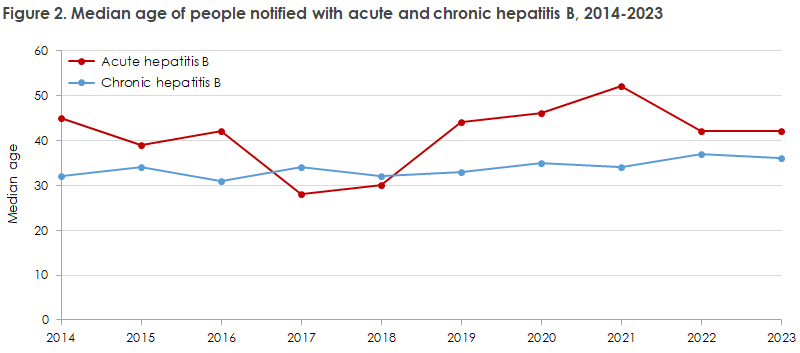
Hepatitis C
For a detailed epidemiological description of the incidence in 2023, refer to the annual report on acute and chronic hepatitis C.
In 2023, the Department of Infectious Disease Epidemiology and Prevention received six reports of acute hepatitis C (all male). By comparison, 11 cases were reported in 2022.
In 2023, 205 cases (71% male) of chronic hepatitis C were reported. In comparison, 196 cases were reported in 2022.
Intravenous drug use remained the most common mode of transmission. Cases were also reported where the mode of transmission was sexual or nosocomial (hospital-acquired abroad).
The number of reported hepatitis C cases in 2023 remained nearly the same as in 2022 but has been declining overall since 2007 (Figure 1).
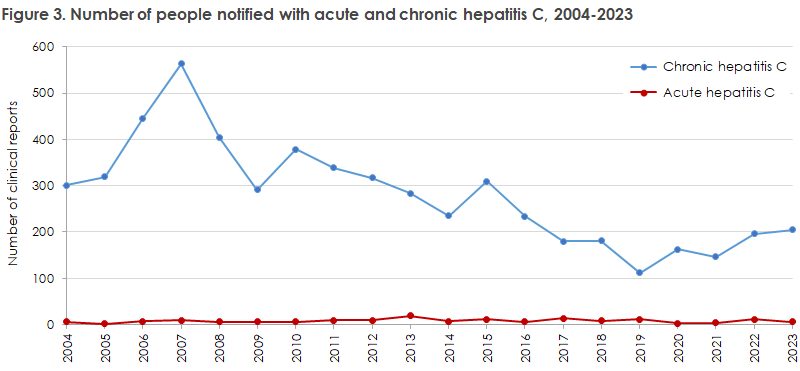
Median Age
The median age of chronically infected individuals increased steadily from 2000 to 2016. Since then, it has stabilized at around 50 years of age. For acutely infected individuals, the median age increased until 2012 and has since fluctuated slightly but remains generally unchanged at around 40 years. However, the low number of acute cases may explain year-to-year fluctuations (Figure 4).
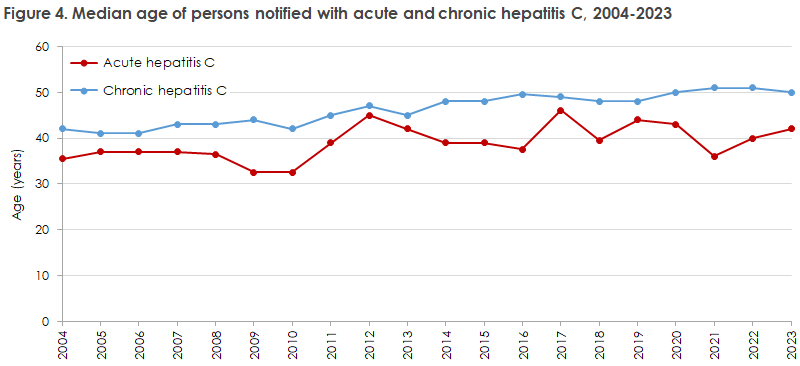
Region and Area
The incidence of reported hepatitis C cases was highest in West and South Zealand in 2023 (10.5 per 100,000 inhabitants). This area also showed the largest increase (from 18 cases of chronic hepatitis C in 2022 to 62 cases in 2023). This significant rise can be attributed to initiatives such as "call-back" (contacting individuals known to have hepatitis C who never received treatment) and "Project C," a mobile outreach team in Region Zealand that identifies, tests, and treats residents infected with hepatitis C, which began in mid-2021. A similar increase was observed in West Jutland (from 13 cases in 2022 to 26 cases in 2023).
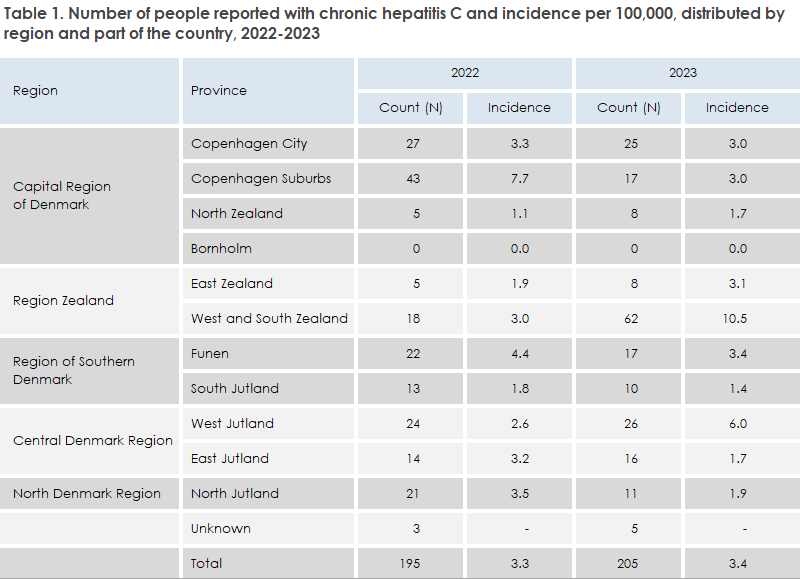
Migrants
The number of reported hepatitis C cases among individuals from Ukraine who arrived in Denmark during 2022 and 2023 continued to rise in 2023. In 2022, 11 cases were reported among Ukrainian individuals who arrived that year, and in 2023, 18 cases were reported among individuals who arrived in 2022 or 2023.
Summary
The incidence of acute hepatitis B has been stable since 2014, while chronic hepatitis B incidence has been steadily declining during the same period.
Acute hepatitis C incidence has been stagnant since 2004. Chronic hepatitis C cases peaked in 2008 with 416 cases and have steadily declined from 2014 to 2019, followed by a slight increase in recent years. This increase likely reflects improved screening and treatment awareness rather than a true rise in incidence.
Over the past decade, there has been no significant change in the risk groups for hepatitis B and C. Most cases of hepatitis B are among non-Danish individuals presumed to have been infected at birth before arriving in Denmark. For hepatitis C, the primary risk group comprises Danish individuals infected through intravenous drug use.
A large portion of the reported cases of hepatitis C have been identified through active case-finding in risk groups. Active case-finding within risk groups has brought Denmark closer to eliminating hepatitis C by 2030, aligning with WHO goals. However, sporadic cases of hepatitis C outside screening initiatives still need to be reported.
Clinical reporting of cases of hepatitis B and C continues to rely on paper or electronic reports submitted by treating physicians or other healthcare professionals. This can potentially lead to underreporting of these cases. Statens Serum Institut has recently been working on establishing laboratory-based surveillance for hepatitis B and C. Once implemented, this system will provide more accurate disease monitoring across the country.
(L.H. Holm, A. Koch, Department of Infectious Disease Epidemiology and Prevention)